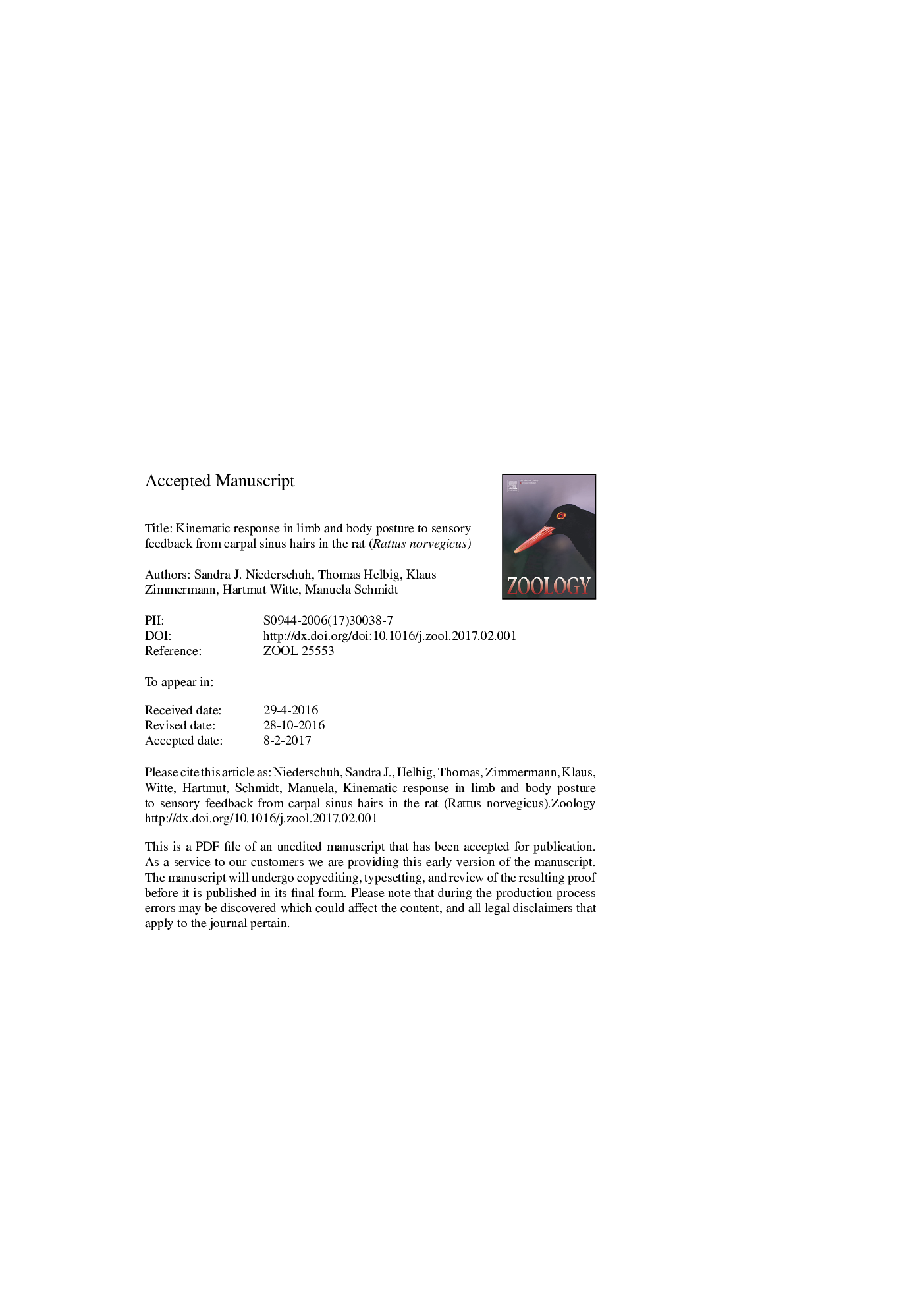| کد مقاله | کد نشریه | سال انتشار | مقاله انگلیسی | نسخه تمام متن |
|---|---|---|---|---|
| 5586559 | 1568637 | 2017 | 47 صفحه PDF | دانلود رایگان |
عنوان انگلیسی مقاله ISI
Kinematic response in limb and body posture to sensory feedback from carpal sinus hairs in the rat (Rattus norvegicus)
دانلود مقاله + سفارش ترجمه
دانلود مقاله ISI انگلیسی
رایگان برای ایرانیان
کلمات کلیدی
موضوعات مرتبط
علوم زیستی و بیوفناوری
علوم کشاورزی و بیولوژیک
علوم دامی و جانورشناسی
پیش نمایش صفحه اول مقاله

چکیده انگلیسی
One of the most challenging adaptations within the therians has been to ensure dynamic stability of the trunk during rapid locomotion in highly structured environments. A reorganization of limb mechanics and development of new sensors has taken place within their stem lineage. Rats, which have a similar lifestyle to the first therians, possess sinus hairs specialized for tactile sensing. It is supposed that carpal sinus hairs have a role in sensing substrate properties and can thus induce adjustments in limb kinematics and body posture according to the different surface diameters and structures detected. This implies a shared sensorimotor control loop of sinus hairs and body posture. To investigate the role of the carpal sinus hairs during locomotion and to explore a possible interaction between limb and spine motion, spatiotemporal and kinematic parameters as well as the contact mechanics of the hairs with regard to the surface were quantified. Locomotion on a treadmill with continuous and discontinuous substrates was compared in the presence/absence of the carpal sinus hairs across a speed range from 0.2Â m/s to 0.6Â m/s. Recordings were taken synchronously using x-ray fluoroscopy and normal-light high-speed cameras. Our investigation revealed that the three tactile hairs made a triangle-like contact with the ground approximately 30Â ms before touchdown of the forelimb. Within that time, it is likely that both the body posture and its oscillation are adjusted according to the different surface textures. The sensory input of the carpal sinus hairs induces a stabilization of the trajectory of the center of mass and, therefore, improves the dynamic stability of the trunk; conversely, the absence of the sensors results in a more crouched frontal body posture, similar to that seen in rats when they are moving in an unknown terrain. The carpal sinus hairs also sense the animal's speed during surface contact. This implicates an adjustment of the limb and spine kinematics, by increasing the speed-dependent effect or by increasing the distance between the trunk and the ground when the rat is walking faster.
ناشر
Database: Elsevier - ScienceDirect (ساینس دایرکت)
Journal: Zoology - Volume 121, April 2017, Pages 18-34
Journal: Zoology - Volume 121, April 2017, Pages 18-34
نویسندگان
Sandra J. Niederschuh, Thomas Helbig, Klaus Zimmermann, Hartmut Witte, Manuela Schmidt,